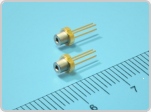
Renesas Electronics announced its first blue-violet semiconductor laser diode with a wavelength of 405nm and a new structure incorporating an optical waveguide into the semiconductor device, which enables high power output and excellent suitability for mass production.
The new blue-violet semiconductor laser diode, part number NV4A61MF, is suitable for Blu-ray disc recording and playback, and features a new inner-stripe structure in which the optical waveguide that substantially influences the quality of the laser diode is incorporated into the semiconductor.
In this new structure, the optical waveguide is fabricated on a gallium nitride (GaN) substrate with approximately ten times improved accuracy and 20 percent increased heat dissipation compared to the conventional devices, in which the optical waveguide is formed on the surface of the laser chip.
With this innovative structure, the new device offers a high optical power output of 350mW suitable for 8x Blu-ray disc recording even at temperatures of up to 85°C. The current and optical output characteristics provide excellent linearity from the low-output range through the high-temperature, high-output range. This reduces laser noise (output fluctuation) that occurs during playback to less than one third of the company's existing devices, realizing 5dB/Hz improvement.
Majority of the existing blue-violet semiconductor laser diodes adopts a ridge-waveguide structure in which dry etching process is used on the semiconductor surface to fabricate an optical waveguide, a path that guides laser light, and current confinement to the light emitting layer, in a ridge formation.
In a laser device, the thickness of the cladding layer formed immediately above the light-emission layer directly determines the device performance. However, the conventional dry etching process makes it difficult to control the cladding layer thickness due to lack of suitable material for etching stopper, which sometimes resulted in inconsistent laser performance.
Renesas Electronics' NV4A61F laser diode adopts the company's newly developed inner-stripe structure, which reduces performance inconsistency while providing robust high-power output and low noise. The epitaxial growth technology that is capable of controlling the layer thickness at a 1nm level, about an atomic layer, improves the accuracy of the fabrication of the cladding layer by ten times compared to the conventional dry etching process.
In addition, to efficiently concentrate current in the light emitting layer, the new laser adopts aluminium nitride (AlN) as the material to form the current blocking layer directly above the cladding layer.
Renesas Electronics aims to expand its lineup of blue-violet laser diode, and expects to release the next 420 mW laser for dual-layer, 12× Blu-ray recording by December, 2010.
The new NV4A61MF blue-violet laser diode is currently available for samples. Mass production is estimated to begin in August, 2010 and is expected to reach 1,000,000 units per month by second half of CY2011. |